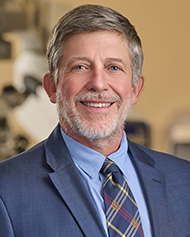
Dr. John Greer is a member of an elite group (2%) of board certified urologists with advanced training in male fertility and sexual dysfunction. Fellowship trained in male reproductive medicine and microsurgery at Baylor University College of Medicine, Dr. Greer specializes in the treatment of male infertility, vasectomy reversal, sperm retrieval, vasectomy, and hormone therapy. Dr. Greer is the most experienced male infertility specialist in the state of Idaho, and patients throughout the Northwest seek out his expertise when dealing with male reproductive medicine.
A native of Atlanta, Georgia, Dr. Greer is a graduate of Auburn University. He received his medical degree from Emory University, and completed his internship and residency at Emory.
Dr. Greer is a member of the American Urological Association, the Idaho Medical Association, the Ada County Medical Society, and the American Society for Reproductive Medicine. He is also a diplomate of the American Board of Urology.

Dr. Wade Muncey is a fellowship-trained urologist with expertise in sexual medicine, male fertility and men’s health. He was born and raised in Spokane, Washington. He attended college locally, earning a degree in biology and chemistry from Whitworth University. He then went on to earn a medical degree from the University of Washington School of Medicine. His surgical training included a year of general surgery and four years of urologic surgery at Case Western Reserve University. This was followed by a year of sub-specialty training in sexual dysfunction and microsurgery at Stanford University in the field of Male Reproductive Medicine and Surgery.
Dr. Muncey specializes in penile implant surgery, treatment for male infertility, sperm retrieval and vasectomy reversal. He is dedicated to providing men access to the latest technologies for conditions such as erectile dysfunction, Peyronie’s Disease, BPH, and low testosterone.
Dr. Muncey is a member of the American Urologic Association, Sexual Medicine Society of North America, and American Society for Reproductive Medicine.

Services provided by Dr. Greer and Dr. Muncey include:
VASOVASOSTOMY: A vasovasostomy is a surgical procedure in which the effects of a vasectomy (male sterilization) are reversed. During a vasectomy, the vasa deferentia, which are ducts that carry sperm from the testicles to the seminal vesicles, are cut, tied, cauterized (burned or seared), or otherwise interrupted. A vasovasostomy creates an opening between the separated ends of each vas deferens so that the sperm may enter the semen before ejaculation.
VARICOCELE REPAIR: A varicocele is a bundle of enlarged veins in a man’s scrotum, which is the sac that holds the two testicles. The veins are usually visible as lumps on the scrotum and feel like a bag of worms when massaged gently. Many men don’t realize they have a varicocele because the veins typically don’t hurt and don’t change the feeling of orgasm or ejaculation. Sperm are made in the testicles, which hang in the scrotum away from the body. This design is required because testicles need to be slightly cooler than normal body temperature to make sperm. Anything that warms the testicles will hurt sperm production. This is what a varicocele does. The extra blood pooling in the enlarged veins warms the nearby testicle unnaturally and cuts sperm production. Varicocele repair can usually be done surgically on an outpatient basis using local or general anesthetic. A small incision is made in the abdomen close to where the testicles originally descended through the abdominal wall. The veins that produce the varicocele are identified and cut to eliminate blood flow to the varicocele.
SPERM RETRIEVAL: Sperm can be successfully retrieved from men in almost any situation using today’s minimally invasive techniques. Sperm retrieval (also known as sperm extraction or sperm aspiration) helps men with a vasectomy, a failed vasectomy reversal, an absence of the vas deferens, or blockages anywhere along the seminal tract (obstructive azoospermia) obtain sperm. Even when the sperm count or quantity is so low it does not make it to the outside world (non-obstructive Azoospermia or NOA), sperm aspiration can help. The four primary sperm retrieval techniques are MESA, PESA, TESE, and Micro-TESE which are often used in conjunction with IVF.
SPERM RETRIEVAL TECHNIQUES:
PESA: Percutaneous Epididymal Sperm Aspiration (PESA) is typically the first choice for sperm retrieval, and is done by inserting a needle through the scrotum into the epididymis to collect a small amount of sperm.
MESA: Microscopic Epididymal Sperm Aspiration (MESA) is slightly more invasive technique than PESA and uses microsurgical techniques to collect sperm from the epididymis.
TESE & MICRO-TESE: Testicular Sperm Extraction (TESE) is done either using a needle or a small incision to collect a small sample of the testis tissue for extraction of sperm. In cases of very low sperm production, a technique known as Microscopic TESE (Micro-TESE) is used to collect sperm from the testis.
SPERM CRYOPRESERVATION: Proven, time-tested techniques enable semen specimens to be frozen and stored indefinitely in liquid nitrogen. According to the donor’s specific wishes, these specimens can later be thawed and used in an attempt to conceive through artificial insemination, IVF or other fertility treatment techniques. Each sample (ejaculate) is mixed with a special media or solution to help provide protection during freezing and thawing. The samples are then placed in special plastic vials, which are coded, and carefully frozen in liquid nitrogen vapor. Once frozen, the vials are immersed in liquid nitrogen in secure tanks at a temperature of -196° C (-371° F). The liquid nitrogen is independent of any source of power, and is regularly checked and replenished. Each patient is assigned a unique “cryo code” and the sperm sample is processed individually using permanently marked vials by our licensed and certified clinical lab scientists.
The insemination procedure involves injecting prepared sperm into the female reproductive tract through the vagina. This procedure is performed by a physician, a skilled registered nurse, or other specialists with special training and experience in the field of fertility treatment. For intrauterine insemination (depositing of sperm into the uterus), the sperm must be specifically prepared or “washed” to prevent possible complications.
Inseminations are performed at the time of or prior to ovulation. Ovulation is determined by monitoring the menstrual cycle, measuring the basal body temperature, evaluating the quality of cervical mucus, using ovulation predictor kits and/or gynecological sonograms.
TESTICULAR BIOPSY AND FINE NEEDLE ASPIRATION: A testicular biopsy (also called a testis biopsy) is an infertility testing procedure where a small sample of tissue from one or both testicles is removed and examined by a male fertility specialist under a microscope to evaluate a man’s ability to father a child. A testicular biopsy may be performed to help determine the cause of male infertility, particularly in cases with azoospermia. A testis biopsy may be done if both of the following are present:
• The man’s semen does not have sperm (azoospermia).
• Hormone test results are within the normal range.








